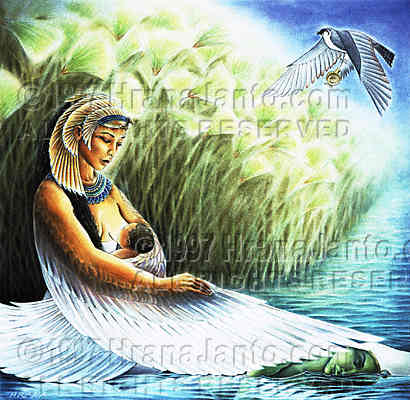 |
|
|||||
PREVIOUS | NEXT | A,B,C, D,E, F,G,H,I, J,K,L,M, N,O,P,Q, R,S, T,U,V,W,X,Y,Z | Help | ALL | INDEX
| Isis from Goddesses and Heroines |
Exerpt from Goddess & Heroines by Patricia
Monaghan [Used by permission. This text is NOT included in the Goddess Oracle] |
Isis of the winged arms, first daughter of Nut, the overarching sky, and the little earth god Geb, was born in the Nile swamps on the first day between the first years of creation. From the beginning, Isis turned a kind eye on the people of earth, teaching women to grind corn, spin flax, weave cloth, and tame men aufficiently to live with them. The goddess herself lived with her brother, Osiris, god of Nile waters and the vegetation that springs up when the river floods.
Alas for Isis, her beloved Osirus was killed by their evil brother, Set. The mourning goddess cut off her hair and tore her robes to shreds, wailing in grief. Then she set forth to locate her brother's body. Eventually Isis arrived in Phoenicia, where Queen Astarte, pitying but not recognizing the pathetic goddess, hired her as nursemaid to the infant prince. Isis took good care of the child, placing him like a log in the palace fire, where the terrified mother found him smoldering. She grabbed the child from the fire, thus undoing the magic of immortality that Isis had been working on the child. (A similar story was told of the mourning Demeter.)
Isis was called on to explain her action, and thus the goddess's identity was revealed and her search explained. And then Astarte had her own revelation: that the fragrant tamarisk tree in the palace contained the body of the lost Osiris. Isis carried the tree-sheltered corpse back to Egypt for burial. But the evil Set was not to be thwarted; he found the body, stole it, and dismembered it.
Isis's search began anew. And this time her goal was not a single corpse, but a dozen pieces to be found and reassembled. The goddess did find the arms and legs and head and torso of her beloved, but she could not find his penis and substituted a piece of shaped gold. Then Isis invented the rites of embalming, for which the Egyptians are still famous, and she applied them with magical words to the body of Osiris. The god rose, as alive as the corn after spring floods in Egypt. Isis magically conceived a child through the golden phallus of the revived Osiris, and that child was the sun god Horus.
There was another tale told of the magician Isis. Determined to have power over all the gods, she fashioned a snake and sent it to bite Ra, highest of gods. Sick and growing weaker, he called for Isis to apply her renowned curative powers to the wound. But the goddess claimed to be powerless to purge the poison unless she knew the god's secret name, his name of power, his very essence. Ra demurred and hesitated, growing ever weaker. Finally, in desperation, he was forced to whisper the word to her. Isis cured him, but Ra had paid the price of giving her eternal power over him. (A like tale was told of Lilith and Jehovah.)
When she was born in Egypt, the goddess' name was Au Set (Auzit, Eset), which means "exceeding queen" or simply "spirit." But the colonizing Greeks altered the pronunciation to yield the now-familiar Isis, a name used through the generations as the goddess's worship spread from the delta of the Nile to the banks of the Rhine. Like Ishtar (of whom a similar tale of loss and restoration was told), Isis took on the identities of lesser goddesses until she was revered as the universal goddess, the total femininity of whom other goddesses represented only isolated aspects.
She became the Lady of Ten Thousand Names, whose true name was Isis. She grew into Isis Panthea ("Isis the All-Goddess"). She was the moon and the mother of the sun; she was mourning wife and tender sister; she was the culture-bringer and health-giver. She was the "throne" and the "Goddess Fifteen." She was a form of Hathor (or that goddess a form of her). She was also Meri, goddess of the sea, and Sochit, the "cornfield."
But she was everlastingly, to her fervent devotees, the blessed goddess who
was herself all things and who promised: "You shall live in blessing, you shall
live glorious in my protection; and when you have furfilled your allotted span
of life and descend to the underworld, there too you shall see me, as you see
me now, shining ... And if you show yourself obedient to my divinity ... you
will know that I alone have permitted you to extend your life beyond the time
allocated you by your destiny." Isis, who overcame death to bring her lover
back to life, could as readily hold off death for her faithful followers, for
the all-powerful Isis alone could boast, "I will overcome Fate."
| Back to TOP | Published by Llewellyn, copyright 1997. Used by permission of the author. |
![]()